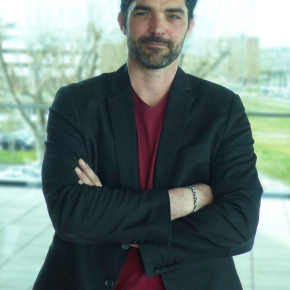Samuel Marre studies the underground storage and conversion of CO2 using his pocket labs
Samuel Marre – Researcher at Institut de chimie de la matière condensée de Bordeaux
It is well-known that matter exists in one of three states: solid, liquid or gaseous. However, at high temperature and pressures another state exists, where liquid and gas cannot be distinguished: supercritical fluid. In Bordeaux, Samuel Marre has made a niche for himself in the creation of tools and protocols for studying and using fluids in these special conditions at small scale. There are many applications such as the development of sustainable processes or the storage and geological bioconversion of CO2.
Samuel Marre is a researcher who is used to working under pressure. The pressure is doubled by high temperature for this scientist from Normandy who moved to Bordeaux in 2000. We are not talking here of the pressure to seek new financing, an obligatory passage for all researchers, or of the difference in temperature between the slopes of Bordeaux and Normandy's apple orchards, but rather of the physical characteristics that apply to his research fields: supercritical fluids.
Supercritical processes
The supercritical field exists for all chemical species. Above a certain temperature and pressure, the distinction between the gaseous and liquid states is no longer possible. A fluid is then simultaneously a liquid and a gas, but in reality is neither the one nor the other. "It is an extremely interesting field," throws out the researcher. "Once the critical point is reached, we can play on the temperature and pressure to attain practically the whole range of density and viscosity that is possible between the gaseous and liquid state." Thus, the density of supercritical CO2 can easily be modulated between 200 and 900 kilograms per cubic metre.
Carbon dioxide is one of the supercritical fluids that is the most used currently. Its critical point (31 °C and 73.9 bar) is relatively accessible, meaning that it can be used in different fields such as material synthesis or extraction. For example, industry uses it to extract caffeine from coffee beans without having recourse to polluting solvents. "The problem" points out Samuel Marre, "is that we work at high pressure. The protocol is similar to that of a pressure cooker. As a result it is difficult to observe the inside of the reactors to improve our understanding of high pressure processes. Many systems exist that have sapphire windows, but this is extremely expensive and the field of vision remains small."
"Recognizing how to seize opportunities when they show up"
Things could have stopped there, but Samuel Marre had an idea. "In 2007, after my thesis, I decided that we should be able to observe supercritical fluids on a small scale using microfluidic approaches. Thus, I went to Klavs Jensen's laboratory in the Massachusetts Institute of Technology for a post-doc. I found myself in the right place at the right time. There were few students and the budgets had not yet been frozen. Jensen said to me: "you can have $100,000 this year. Find me something, and we'll talk figures again next year."" That 'something,' Samuel Marre materialised in a transparent tool that could be contained in the chip of a visa card. The tool is capable of containing fluids up to 300 bars. "At that scale, the mechanism of fluids remained the same and we could vary the experimental conditions extremely rapidly. It was perfect for re-examining all known processes and to carry out high flow-through experiments."
Samuel Marre failed the competitive exam for entry into the CNRS twice after his time at MIT. "Scientific excellence was not sufficient to join a CNRS laboratory; the other candidates also felt this." Samuel Marre succeeded in the competitive examination in 2009 but the continuation of his work remained complicated. "For the first two years, I had trouble finding funding. But today it's done! My pocket laboratories, or "labs in a chip" are used in many projects, such as studies linked to the reduction of anthropogenic CO2, especially the capture and geological storage of CO2 or the optimisation of processes. I even succeeded in obtaining an ERC grant to assess the recovery of CO2 from methane in geological environments due to microorganisms (the BIG MAC project – www.erc-bigmac.cnrs.fr). Opening towards new disciplines and interdisciplinarity lead me to evolve and to re-think my work constantly. My career has made me capable of recognizing how to seize opportunities when they arise!"
